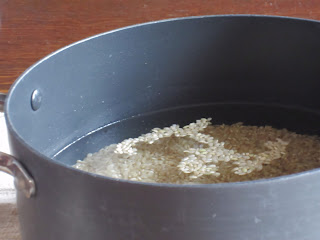Something about the
frame of mind during the Great Depression fascinates me. For the man, usually the head of the
household back then, it must have been a demoralizing time. Meanwhile the female often had to make do with
whatever she had on hand and could not run out to the local Jewel.
My grandparents raised
their families during the Great Depression.
My maternal grandparents lived on a farm and found that era to be
more bearable than others who did not live the self-sufficient life. Things were tough for my paternal
grandparents, though, for they lived in the city.
My grandfather took whatever jobs could be had, such as shoveling coal for
homeowners' heating needs.
There once were coal
bin doors on the side of people’s homes and Grandpa would shovel coal into the homes
this way. He also delivered ice to
homes, as refrigeration was performed via ‘ice boxes’ back then. My own father and uncle would help out by
selling eggs door to door. My DH’s own
grandfather lost his job with the railroad during the Great Depression and had
to earn a living digging graves. Life
was tough.
Since that generation
is starting to pass away and no longer available for picking their brains (or
their memories have faded), it is interesting to research available media
as to the little ways homemakers made ends meet.
I plan to write a series on this topic and would like to begin with a very
simple tip I found that would save money by conserving energy and yet provide a very healthy and affordable alternative to
white rice.
As I perform my research, I have grown rather
fond of Miss Meade’s column for housewives (Chicago Daily Tribune, 1936) for “guiding housewives to the best
knowledge of cookery, hostessing, and budgeting.” (So you mean they still had time and money
for hostessing during the Great Depression?)
By the way, my computer flagged ‘hostessing’ as an unknown word:)
Miss Meade explains
what brown rice is and is not.
Apparently, Chicagoans, where Meade’s column had its readership,
believed brown rice to be something that was white rice cooked in such a way to
render it brown. Brown rice is, in fact, rice with its nourishing outer layers still intact. She then explains an
energy-saving method of cooking brown rice.
This is the tip I love since one of my beefs with brown rice is the
lengthy cook time.
Measure out 2 cups of brown rice.
Soak the pot of rice for at least 1 hour to soften the outer bran layer and to rid it of some of the starch. (I soaked the rice for over 2 hours.)
In the pic below, the left-hand rice is raw brown rice, while the right side is what it looks like after soaking.
Pour this off and refill a pot with 2 quarts of water, bring to a boil and pour in the rice and a teaspoon of salt. Fluff with fork occasionally until tender (I omitted the fluffing).
I altered this a bit after the first trial run to be 1 cup rice with 2 cups water and left out the salt, brought to a boil and simmered for 20 minutes, covered.
I found this method to work and wondered why I did not learn of this method before? Oldies are indeed goodies;)
NATURE AND USE OF
BROWN RICE ARE DISCUSSED: Delectable Dishes Employ Its Hearty Meade, Mary
Chicago Daily
Tribune (1923-1963); Jan
10, 1936;ProQuest Historical Newspapers: Chicago Tribune.



